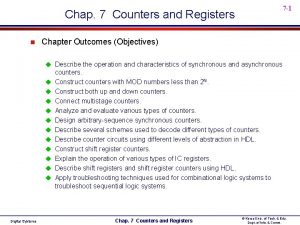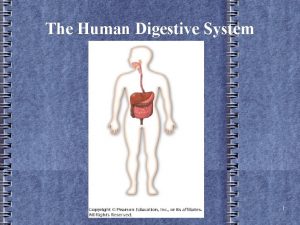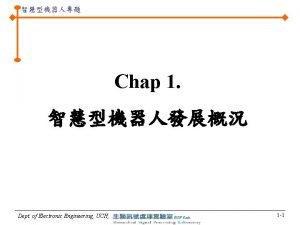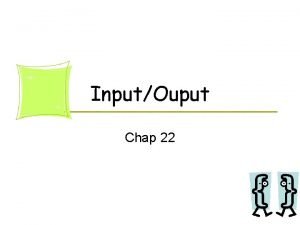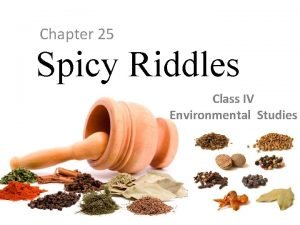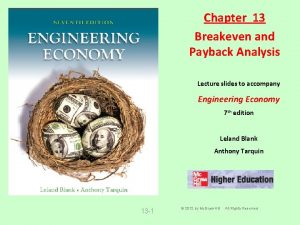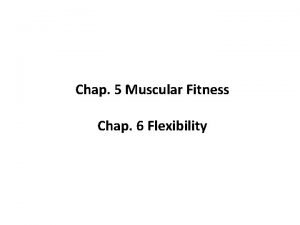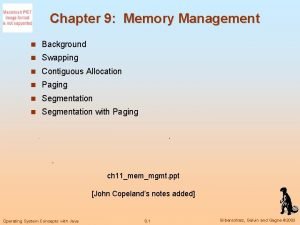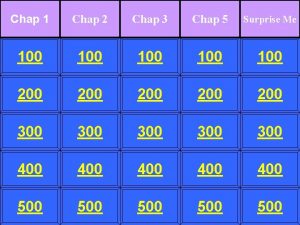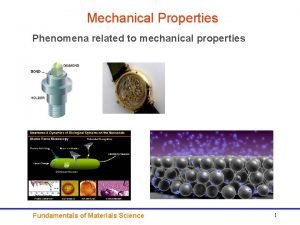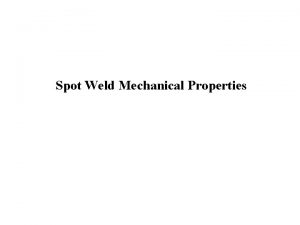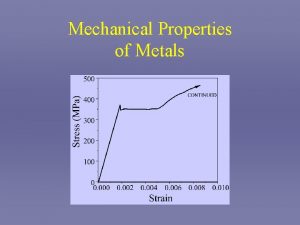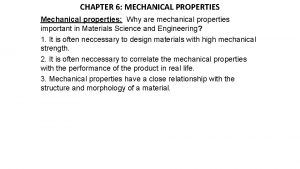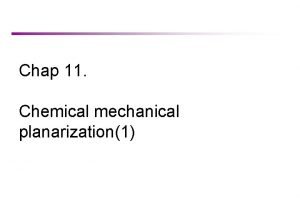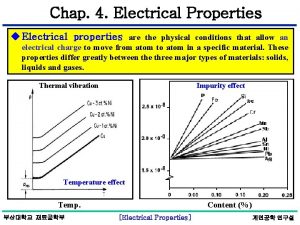Chap 3 Mechanical Properties u Mechanical Properties mechanical


![Chap. 3. Mechanical Properties Stress [load per area] u Plastic deformation is a change Chap. 3. Mechanical Properties Stress [load per area] u Plastic deformation is a change](https://slidetodoc.com/presentation_image_h2/8a13fa69ac6b33ca977da2a335d65b3c/image-3.jpg)

![Chap. 3. Mechanical Properties 부산대학교 재료공학부 [deformation in metals] 계면공학 연구실 Chap. 3. Mechanical Properties 부산대학교 재료공학부 [deformation in metals] 계면공학 연구실](https://slidetodoc.com/presentation_image_h2/8a13fa69ac6b33ca977da2a335d65b3c/image-5.jpg)



![Chap. 3. Mechanical Properties u Slip system: set of [slip plane + slip direction] Chap. 3. Mechanical Properties u Slip system: set of [slip plane + slip direction]](https://slidetodoc.com/presentation_image_h2/8a13fa69ac6b33ca977da2a335d65b3c/image-9.jpg)


![Chap. 3. Mechanical Properties slip twin 부산대학교 재료공학부 [deformation in metals] 계면공학 연구실 Chap. 3. Mechanical Properties slip twin 부산대학교 재료공학부 [deformation in metals] 계면공학 연구실](https://slidetodoc.com/presentation_image_h2/8a13fa69ac6b33ca977da2a335d65b3c/image-12.jpg)


![Chap. 3. Mechanical Properties u How about deformation mechanisms in the Ceramics [Ceramics] 부산대학교 Chap. 3. Mechanical Properties u How about deformation mechanisms in the Ceramics [Ceramics] 부산대학교](https://slidetodoc.com/presentation_image_h2/8a13fa69ac6b33ca977da2a335d65b3c/image-15.jpg)


![Chap. 3. Mechanical Properties [Homework #3] / Due date: before next class 1. Describe Chap. 3. Mechanical Properties [Homework #3] / Due date: before next class 1. Describe](https://slidetodoc.com/presentation_image_h2/8a13fa69ac6b33ca977da2a335d65b3c/image-18.jpg)
- Slides: 18

Chap. 3. Mechanical Properties u Mechanical Properties: mechanical properties of a material are those properties that involve a reaction to an applied load. v Wear 부산대학교 재료공학부 [Mechanical Properties] 계면공학 연구실

Chap. 3. Mechanical Properties u Deformation: in materials science, deformation refers to any changes in the shape or size of an object due to an applied force or a change in temperature. The first case can be a result of tensile (pulling) forces, compressive (pushing) forces, shear, bending or torsion (twisting). In the second case, which is determined by the temperature, is the mobility of the structural defects such as grain boundaries, point vacancies, line and screw dislocations, stacking faults and twins in both crystalline and non-crystalline solids. The movement or displacement of such mobile defects is 부산대학교 재료공학부 연구실 in metals] thermally activated, and[deformation thus limited by the rate of계면공학 atomic
![Chap 3 Mechanical Properties Stress load per area u Plastic deformation is a change Chap. 3. Mechanical Properties Stress [load per area] u Plastic deformation is a change](https://slidetodoc.com/presentation_image_h2/8a13fa69ac6b33ca977da2a335d65b3c/image-3.jpg)
Chap. 3. Mechanical Properties Stress [load per area] u Plastic deformation is a change of the material dimensions remaining after removal of the load caused the deformation. v Plastic deformations in metals occurs by “slip” mechanism. Strain gauge Gauge length Strain [elongation per length] 부산대학교 재료공학부 [deformation in metals] 계면공학 연구실

Chap. 3. Mechanical Properties u Tensile testing, also known as tension testing, is a fundamental materials science test in which a sample is subjected to a controlled tension until failure. Slip 부산대학교 재료공학부 [deformation in metals] Twin 계면공학 연구실
![Chap 3 Mechanical Properties 부산대학교 재료공학부 deformation in metals 계면공학 연구실 Chap. 3. Mechanical Properties 부산대학교 재료공학부 [deformation in metals] 계면공학 연구실](https://slidetodoc.com/presentation_image_h2/8a13fa69ac6b33ca977da2a335d65b3c/image-5.jpg)
Chap. 3. Mechanical Properties 부산대학교 재료공학부 [deformation in metals] 계면공학 연구실

Chap. 3. Mechanical Properties u Elongation( ) : the state of being elongated or lengthened; also : the process of growing or increasing in length. Elastic deformation 부산대학교 재료공학부 [deformation in metals] 계면공학 연구실

Chap. 3. Mechanical Properties u Plastic deformation: occurrence of permanent deformation Plastic deformation Slip and slip system? 부산대학교 재료공학부 [deformation in metals] 계면공학 연구실

Chap. 3. Mechanical Properties u Plastic deformation in metals: related to the slip of atoms over atoms like following the figure. 부산대학교 재료공학부 [deformation in metals] 계면공학 연구실
![Chap 3 Mechanical Properties u Slip system set of slip plane slip direction Chap. 3. Mechanical Properties u Slip system: set of [slip plane + slip direction]](https://slidetodoc.com/presentation_image_h2/8a13fa69ac6b33ca977da2a335d65b3c/image-9.jpg)
Chap. 3. Mechanical Properties u Slip system: set of [slip plane + slip direction] in the metals. closed packed planes and directions. [FCC] Point: D가 짧을수록 d가 클수록 소성변형이 용이함. [BCC] The required force for slip? 2 부산대학교 재료공학부 [deformation in metals] 계면공학 연구실

Chap. 3. Mechanical Properties u Number of slip system is important factor affecting slip [FCC] [BCC] 부산대학교 재료공학부 [deformation in metals] 계면공학 연구실

Chap. 3. Mechanical Properties u Deformation mechanism in the metals: slip / twin slip 부산대학교 재료공학부 [deformation in metals] 계면공학 연구실
![Chap 3 Mechanical Properties slip twin 부산대학교 재료공학부 deformation in metals 계면공학 연구실 Chap. 3. Mechanical Properties slip twin 부산대학교 재료공학부 [deformation in metals] 계면공학 연구실](https://slidetodoc.com/presentation_image_h2/8a13fa69ac6b33ca977da2a335d65b3c/image-12.jpg)
Chap. 3. Mechanical Properties slip twin 부산대학교 재료공학부 [deformation in metals] 계면공학 연구실

Chap. 3. Mechanical Properties u Absorbing energy: resilience and toughness 부산대학교 재료공학부 [deformation in metals] 계면공학 연구실

Chap. 3. Mechanical Properties u How about microstructure after plastic deformation in the metal Change in microstructure 부산대학교 재료공학부 [deformation in metals] 계면공학 연구실
![Chap 3 Mechanical Properties u How about deformation mechanisms in the Ceramics Ceramics 부산대학교 Chap. 3. Mechanical Properties u How about deformation mechanisms in the Ceramics [Ceramics] 부산대학교](https://slidetodoc.com/presentation_image_h2/8a13fa69ac6b33ca977da2a335d65b3c/image-15.jpg)
Chap. 3. Mechanical Properties u How about deformation mechanisms in the Ceramics [Ceramics] 부산대학교 재료공학부 [deformation in Ceramics] 계면공학 연구실

Chap. 3. Mechanical Properties u How about deformation mechanisms in the Polymers 부산대학교 재료공학부 [deformation in Polymers] 계면공학 연구실

Chap. 3. Mechanical Properties u How about deformation mechanisms in the indentation indenter 부산대학교 재료공학부 [deformation in Indentation] 계면공학 연구실
![Chap 3 Mechanical Properties Homework 3 Due date before next class 1 Describe Chap. 3. Mechanical Properties [Homework #3] / Due date: before next class 1. Describe](https://slidetodoc.com/presentation_image_h2/8a13fa69ac6b33ca977da2a335d65b3c/image-18.jpg)
Chap. 3. Mechanical Properties [Homework #3] / Due date: before next class 1. Describe plastic deformation behavior in FCC, BCC and HCP. 2. Define importance of slip system in plastic deformation. 3. Describe behavior of tensile testing in Ceramics. 4. Describe behavior of tensile testing in Polymers. 5. Compare properties of hardness and toughness in materials. 부산대학교 재료공학부 계면공학 연구실
 Chap chap slide
Chap chap slide Chap counter
Chap counter The origin of species chapter 1 mangabuddy
The origin of species chapter 1 mangabuddy Fashion clothes meaning
Fashion clothes meaning Business performance chapter 4
Business performance chapter 4 Chap 23
Chap 23 Swapping chap 21
Swapping chap 21 Electronic engineering
Electronic engineering In the summer chap 22
In the summer chap 22 If your right hand offends you
If your right hand offends you System engineer chap 1
System engineer chap 1 Chap 22
Chap 22 Cardamom riddles
Cardamom riddles Payback chapter 13
Payback chapter 13 Fitness chap 1
Fitness chap 1 Swapping chapter 6
Swapping chapter 6 Fitness ch 1
Fitness ch 1 The origin of species chap 24
The origin of species chap 24 Electrolysis khan academy
Electrolysis khan academy

